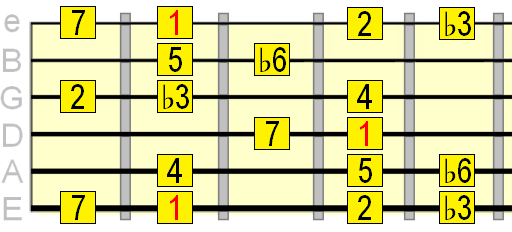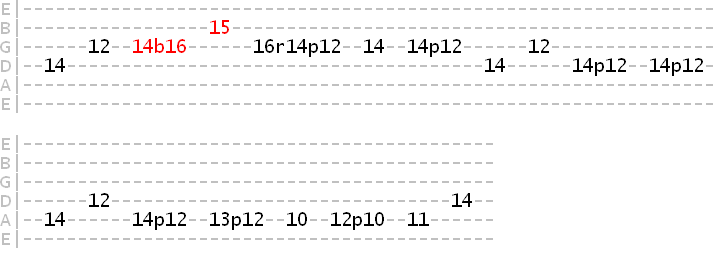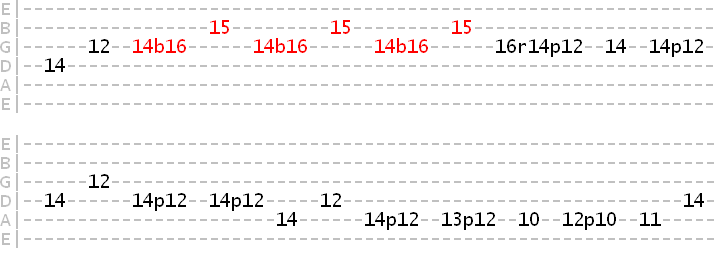1. Learn the Lick in Different Keys
It sounds obvious, but a lot of guitarists learn a lick in a specific key, and then forget about it when it comes to playing in a different key.
Do not filter your licks by key!
Let's say the tab shows you how to play a lick in C minor. Would you be confident playing that same lick in C♯, E♭, F, A♭?
Practice the lick in different keys by moving it to different fret positions. Test your knowledge of the lick by picking a random key and then playing the lick in that key.
2. Learn the Lick in Different Positions on the Neck
Another mistake guitarists make is only learning a lick in one position on the fretboard, or playing the notes on a fixed set of strings.
Let's say you've learned the following lick in the 5th fret position...

Take
the lick's first note and find it on an adjacent string. For example,
the above lick starts on the G
string at the 5th
fret (the note C),
so you
could find that same note on the D
string at the 10th
fret and play the
lick from there...

And don't forget an octave
higher (from the original position) at the 17th fret...

Being able to play a lick in different positions like this gives you the freedom to play it no matter where you are on the fretboard, without having to jump to the original position shown in the tab every time.
Your lick will sound more connected to the rest of your solo and "in the moment" if you can play it in your current position.
It's
also a great ear training exercise, as you'll have to internalise the
relationship between each note in the lick to transfer it to another
part of the neck.
3. Don't Just Start the Lick on the 1st Beat
Instead of starting the lick on the first beat, try starting on the 2nd or 3rd beat or even starting off the beat (in between beats).
For example, take this lick, starting on the 1st beat...

Now let's wait until the 2nd
beat before we start it...
Or, start it between the
1st and 2nd beat (on the "and" - 1 and 2 and 3 and 4 and etc.)...
We can even push it back before the 1st beat so the first part of the
lick provides a "lead in"...
So by experimenting with accenting different beats and off-beats, you
can find the most effective place to start your lick.
4. Try Different Tempos and Timings
As well as being useful for getting up to speed with a lick, use a metronome to practice the lick at different tempos. Try increasing the BPM in increments of 10, but only notch it up when you can play at the current tempo flawlessly.
Try playing the lick in quarter, eighth and sixteenth notes. You can find a good introduction to these note values in the introductory lead guitar timing lesson.
Also, try breaking up the lick by holding/lengthening notes (especially
if there's a bend or vibrato). Similarly, try shortening notes.
5. Know What Scale the Lick is In
If you've created the lick yourself, it will have most likely come out
of noodling around a scale. If you got the lick from someone else, they
should tell you which scale it's derived from. If not, the only way
to find out is to either contact the person who created the lick, or
even better, have a good
knowledge of scales, so you'll hear the scale's colour and
tonality dominate the lick.
Being able to connect a lick to a scale is crucial if you want to be able to connect it to other parts of your solo, since most solos are written around scales (whether intentionally or not).
For example, if I played the following lick...

...my knowledge of the harmonic
minor scale would tell me which pattern is
being used and therefore where any related scale tones lie. I can then
continue the lick in the same position and connect the lick more
fluidly to the rest of my solo...

This leads on nicely to the next point...
6. Practice Connecting Your Licks
Yes, sometimes the most obvious points are the ones guitarists overlook. Having a hundred and one licks under your fingers is great, but unless you want a disjointed and "crowbarred" sound, you'll want to spend time connecting licks in the same key and scale together smoothly.
How? Look for shared notes, link up licks with notes from their scale (see point #5) and use legato techniques such as bends and slides to transition through licks in a fluid way.
Of course, the disjointed sound (e.g. jumping from a low to high
pitched lick) is sometimes desirable - sometimes a
large interval leap between licks can give your solo a wonderfully
climactic
feeling. But keep your options open and practice both unconnected and
connected phrases.
7. sdrawkcaB kciL eht nraeL
Yes, you read that right - learn the lick backwards! This won't work for every lick, but try reversing the sequence of notes to give you yet another variation on the original lick.
For example, if a lick ascends from low to high, try also descending from
high to low.
8. Add Repetition to Your Licks
Repetition is not necessarily lazy. It often sounds good to reiterate a particular sequence in your lick.
For example, take note of the highlighted part
of this bluesy pentatonic lick...

Now I'm going to repeat that highlighted part a couple of times before
I complete the
lick...

Repetition
is about extracting the most possible "value" from a
sequence of notes that sound particularly good but whose full impact
would perhaps be lost if played only once. This is especially useful
for padding out quicker tempo licks.
9. Add Your Own Embellishments
No lick is set in stone. Try adding in notes, changing notes, adding in bends, slides, hammer-ons/pull-offs.
This is your chance to really make the lick your own, and it's what the world's greatest guitarists do all the time (some even admit they take old licks and shine them up!).
Also, make sure you practice variation. That means every time you play the lick, try improvising something new. It could be something as subtle as adding an extra bend, or something more elabroate like a quick run to the next note.
This will train your fingers to co-ordinate more accurately with spontaneous ideas. A
skill all improvising guitarists need, and one that can only be
achieved through the art of practicing
randomness.
10. Practice Your Licks Over Backing Tracks
Once you're confident with timing your lick to a metronome, it's important to get used to playing it to musical accompaniment.
Many guitarists are thrown off track when they come to play their well practiced licks in a band situation. The reason is simply that there is a lot more going on when you're soloing over other musical elements vs a click track. It's a whole different ball game, so make sure you scour the Tube for some good tracks, or record your own using a free program like Audacity to truly put your lick into context.
By following these 10 points, you'll squeeze the most possible potential out of every lick you learn and the line between playing random licks and crafting a meaningful, expressive solo will begin to blur.

